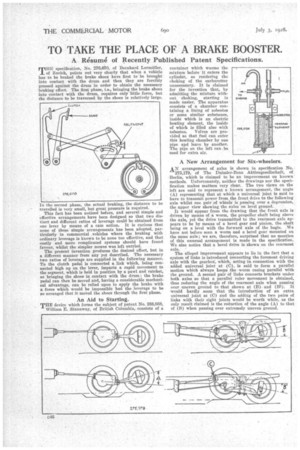TO TAKE THE PLACE OF A BRAKE BOOSTER.
Page 68

If you've noticed an error in this article please click here to report it so we can fix it.
A R4sum4 of Recently Published Patent Specifications.
TIIE specification, No. 276,670, of Bernhard Lormiiller, of Zurich, points out very clearly that when a vehicle has to be braked the brake shoes have first to be brought into contact with the drum and then they are forcibly pressed against the drum in order to obtain the necessary braking effect. The first phase, i.e., bringing the brake shoes into contact with the drum, requires only 'little force, but the distance to be traversed by the shoes is relatively large.
in the second phase, the actual braking, the distance to be travelled is very small, but great pressure is required. This fact has been noticed before, and several simple and effective arrangements have been designed so that two distinct and different ratios of leverage could be obtained from one lever by means of a cam action, it is curious that none of these simple arrangements has been adopted, particularly in commercial vehicles where the braking with ordinary leverage is known to be none too effective, and that costly and more complicated systems should have found favour, whilst the simpler means was left untried.
The present invention produces the desired effect, but in a different manner from any yet described. The necessary two ratios of leverage are supplied in the following manner. To the clutch pedal is connected a link which, being connected high up on the lever, imparts a rapid movement to the segment, which is held in position by a pawl and ratchet, so bringing the shoes in contact with the drum ; the brake pedal can then be moved and, having a considerable mechanical advantage, can be relied upon to apply the brake with a force which would be impossible had the leverage to be so arranged that it moved the shoes through the first phase.
An Aid to Starting.
THE device which forms the subject of patent No. 288,038, William E. Stanaway, of British Columbia, consists of a
container which warms the mixture before it enters the cylinder, so rendering the choking of the carburetter unnecessary. It is claimed for the invention that, by admitting the mixture without choking, starting is made easier. The apparatus consists of a chamber con, taming a lining of asbestos or some similar substance, inside whichis an electric heating element, the inside of which is filled also with
asbestos. Valves are provided so that fuel can enter this heating chamber by one pipe and leave by another. The pipe on the left can.be used for extra air.
A New Arrangement for Six-wheelers.
AN arrangement of axles is shown in specification No.
275,179, of The Daimler-Benz Aktiengesellschaft, of Berlin, which is claimed to be an improvement on known. methods. Unfortunately, neither the drawings nor the specification makes matters very clear. The two views on the left are said to represent a known arrangement, the angle (A) representing that at which a universal joint is said to have to transmit power from the front drive to the following axle whilst one pair of wheels is passing over a depression,
the upper view showing the axles on level ground. '
It would appear from the drawing that the front axle is driven by means of a worm, the propeller shaft being above the axle, yet the drive transmitted to the rearmost axle appears to be by means of a bevel gear and pinion, the shaft being on a level with the forward axle of the bogie. _We have not before seen a worm and a bevel gear mounted on the same axle; we are, therefore, surprised that no mention of this unusual arrangement is made in the specification. We also notice that a bevel drive is shown on the rearmost axle.
The alleged improvement appears to lie in the fact that a system of links is introduced connecting the foremost driving axle with the gearbox, which, acting in connection with the added universal joint at (C), is said to form a parallel motion which always keeps the worm casing parallel with the ground. A second pair of links connects brackets under both axles so that a parallel ruler movement is obtained, thus reducing the angle of the rearmost axle when passing over uneven ground to that shown at (B). and (BI). It would hardly seem that the introduction of an extra universal joint at (C) and the adding of the two pairs of links with their eight joints would be worth while, as the only result claimed is the reduction of the angle (A) to that of (D) when passing over extremely uneven ground.












































































































